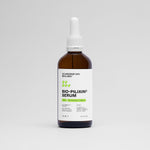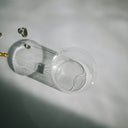Hair loss can be a distressing experience for many individuals, leading them to seek effective treatments. Among the most commonly discussed medications for hair loss are Propecia and finasteride. Understanding the differences and similarities between these two can help individuals make informed decisions about their hair restoration options.
Table of content
Propecia vs Finasteride: What’s the Difference?
Propecia and finasteride are essentially the same medication; Propecia is the brand name, while finasteride is the generic name. Both are used primarily to treat male pattern baldness and work by inhibiting the enzyme 5-alpha reductase, which converts testosterone into dihydrotestosterone (DHT). High levels of DHT are associated with hair loss in men. By reducing DHT levels, both Propecia and finasteride help to slow hair loss and promote regrowth in some users.
While the active ingredient in Propecia is finasteride, there are some important distinctions between the two, particularly in terms of formulation, dosage, and branding. Propecia is specifically marketed for the treatment of male pattern baldness and is typically prescribed at a dose of 1 mg per day. On the other hand, finasteride is available in different formulations and dosages, including a 5 mg version that is primarily used to treat benign prostatic hyperplasia (BPH) in men.
As your leading source for hair health information over the past 4 years, we never compromise on accuracy. When it comes to your health, you deserve information you can truly rely on - and earning your trust is our top priority.
Here's how Scandinavian Biolabs ensures every piece of content meets the highest standards of accuracy and integrity:
- Credentialed Experts: Our reviewers are actively practicing doctors and medical researchers
- Stringent Reviews: Content undergoes rigorous editing by subject specialists and review by a practicing doctor.
- Evidence-Based: We rely on well-established research from trusted scientific sources like peer-reviewed journals and health authorities.
- Full Transparency: Our editorial standards, writer credentials, reviewer credentials, correction process, and funding are all publicly documented.
- Independent Voice: While we do promote products, we operate in a vacuum to business operations. Our main goal is just an unwavering commitment to providing medically-sound guidance.
You can count on Scandinavian Biolabs to consistently deliver the trustworthy health information you deserve. Read our Editorial Standards.
How Do Propecia and Finasteride Work?
Both Propecia and finasteride function by blocking the action of 5-alpha reductase. This enzyme plays a crucial role in the hair loss process by converting testosterone into DHT, which is known to shrink hair follicles and shorten the hair growth cycle. By inhibiting this enzyme, both medications effectively lower the levels of DHT in the body, which can lead to increased hair growth and a reduction in hair loss over time.
Effectiveness of Propecia vs Finasteride
Clinical studies have shown that Propecia is effective for many men experiencing male pattern baldness. Around 65% of users report regrowth of hair after one year of consistent use. Finasteride, when used at the same dosage as Propecia, has similar efficacy rates. The choice between the two often comes down to personal preference, cost, and availability, as generic finasteride may be more affordable than the branded version, Propecia.
Side Effects of Propecia and Finasteride
Both Propecia and finasteride may cause side effects, though not everyone experiences them. Common side effects include decreased libido, erectile dysfunction, and ejaculation disorders. These side effects are generally rare, affecting a small percentage of users. It’s important for individuals to consult with a healthcare provider before starting treatment to discuss potential risks and benefits.
Cost Comparison: Propecia vs Finasteride
Cost can be a significant factor in choosing between Propecia and finasteride. Propecia is typically more expensive due to its brand name status, while generic finasteride is often available at a lower cost. This price difference may influence some patients' decisions, especially if they plan to use the medication long-term, as hair loss treatment usually requires ongoing use to maintain results.
Which One Should You Choose?
The choice between Propecia and finasteride largely depends on individual circumstances, including budget, tolerance to side effects, and personal preferences. Consulting with a healthcare professional can provide valuable insights tailored to individual needs. For those looking for a cost-effective option, generic finasteride may be the preferred choice, while others might opt for Propecia for its established brand recognition.
Conclusion
In summary, Propecia and finasteride serve the same fundamental purpose in treating male pattern baldness, with Propecia being the branded version and finasteride the generic alternative. Both medications can be effective in reducing hair loss and promoting regrowth, but important differences in cost, potential side effects, and personal preferences play a crucial role in the decision-making process. Ultimately, consulting with a healthcare provider is essential for determining the best course of action for managing hair loss.
Tired of Thinning Hair? Try a Clinically Tested Serum.
Looking for a natural way to regrow hair and achieve a thicker, fuller head of hair? Ditch the stinging nettle for hair loss – Bio-Pilixin Serum is a drug-free hair activation serum that delivers clinically tested results.
Here's why Bio-Pilixin is superior:
- Clinically Tested Results: 93% of users saw a reduction in hair loss, and 73% experienced increased hair density.
- Safe and Natural: Unlike harsh chemicals, Bio-Pilixin uses plant growth factors derived from stem cell technology to nourish hair follicles and stimulate growth.
- Fast-Acting: See visible results in as little as 45 days (most typically see results within 150 days).
Stop wasting time on unproven remedies. Bio-Pilixin is the safe & effective serum you've been searching for.
Read more:






